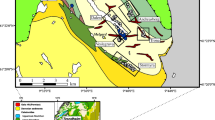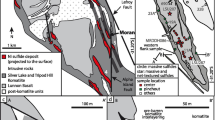Abstract
The Kabanga deposit constitutes one of the most significant Ni sulfide discoveries of the last two decades (indicated mineral resource 23 Mt of ore at 2.64% Ni, inferred resource 28.5 Mt at 2.7% Ni, November 2008). The sulfides are hosted by predominantly harzburgitic and orthopyroxenitic intrusions that crystallized from magnesian basaltic and picritic magmas. However, compared with other sulfide ores that segregated from such magmas (e.g., Jinchuan, Pechenga, Raglan), most Kabanga sulfides have low Ni (<1–3%), Cu (∼0.1–0.4%), and PGE contents (≪1 ppm), high Ni/Cu (5–15), and low Ni/Co (10–15) and Pd/Ir (2–20). Sulfides with higher metal contents (up to ∼5% Ni, 0.8% Cu, 10 ppm PGE) are found in only one unit from Kabanga North. The observed metal contents are consistent with segregation of magmatic sulfides from fertile to strongly metal-depleted magmas, at intermediate to very low mass ratios of silicate to sulfide liquid (R factors) of approximately 10–400. Sulfide saturation was triggered prior to final emplacement, by assimilation of up to 50% of the total sulfur in the intrusions from sulfide-bearing metasedimentary country rocks. Immiscible sulfide liquid was entrained by the magma and ultimately precipitated in dynamic magma conduits that formed tubular and sill-like mafic–ultramafic bodies characterized by abundant magmatic breccias, highly irregular layering, and frequent compositional reversals. The unusually large degree of crustal contamination and the low R factors render Kabanga an end-member in the spectrum of magmatic Ni sulfide ores.













Similar content being viewed by others
References
Baker DR, Barnes S-J, Simon G, Bernier F (2001) Fluid transport of sulfur and metals between sulfide melt and basaltic melt. Can Mineralogist 39:537–546
Barnes SJ, Fiorentini ML (2008) Iridium, ruthenium and rhodium in komatiites: evidence for iridium alloy saturation. Chem Geol 257:44–58
Barnes S-J, Lightfoot PC (2005) The formation of magmatic nickel-copper-PGE sulfide deposits. Econ Geol 100th Ann Vol: 179–213
Barnes S-J, Maier WD (1999) The fractionation of Ni, Cu and the noble metals in silicate and sulphide liquids. In: Keays RR, Lesher CM, Lightfoot PC, Farrow CEG (eds) Dynamic processes in magmatic ore deposits and their application to mineral exploration. Geol Assoc Can, Short Course Notes 13:69–106
Barnes S-J, Picard C, Giovenazzo D, Tremblay C (1992) The composition of nickel-copper sulphide deosits and their host rocks from the Cape Smith Fold Belt, northern Quebec. Austr J Earth Sci 39:335–347
Barnes S-J, Makovicky E, Karup-Moller S, Makovicky M, Rose-Hansen J (1997) Partition coefficiants for Ni, Cu, Pd, Pt, Rh and Ir between monosulfide solid solution and sulfide liquid and the implications for the formation of compositionally zones Ni-Cu sulfide bodies by fractional crystallization of sulfide liquid. Can J Earth Sci 34:366–374
Barnes S-J, Melezhik VA, Sokolov SV (2001) The composition and mode of formation of the Pechenga nickel deposits, Kola Peninsula, northwestern Russia. Can Min 39:447–471
Becker M, Le Roex AP (2006) Geochemistry of South African on- and off-craton, Group I and Group II kimberlites: petrogenesis and source region evolution. J Petrology 47:673–703
Bédard LP, Barnes S-J (2002) A comparison of the capacity of FA-ICP-MS and FA-INAA to determine platinum-group elements and gold in geological samples. J Radioanalyt Nucl Chem 254:319–329
Boyd FR (1989) Compositional distinction between oceanic and cratonic lithosphere. Earth Planet Sci Lett 96:15–26
Campbell IH, Naldrett AJ (1979) The influence of silicate:sulfide ratios on the geochemistry of magmatic sulfides. Econ Geol 74:1503–1505
Chung H-Y, Mungall JE (2009) Physical constraints on the migration of immiscible fluids through partially molten silicates, with special reference to magmatic sulfide ores. Earth Planet Sci Lett 286:14–22
Deblond A (1994) Geologie et petrologie des Massifs basiques et ultrabasiques de la ceinture Kabanga-Musongati au Burundi. Musée Royal de L’Afrique Centrale, Annales, Sciences Geologiques 99:123
Deblond A, Punzalan LE, Boven A, Tack L (2001) The Malagarazi Supergroup of southeast Burundi and its correlative Bukoba Supergroup of northwest Tanzania: Neo- and Mesoproterozoic chronostratigraphy constraints from Ar-Ar ages on mafic rocks. J Afr Earth Sci 32:435–449
Drüppel K, Littmann S, Romer RL, Okrusch M (2007) Petrology and isotope geochemistry of the Mesoproterozoic anorthosite and related rocks of the Kunene intrusive Complex, NW Namibia. Prec Res 156:1–31
Duchesne J-C, Liegeois J-P, Deblond A, Tack L (2004) Petrogenesis of the Kabanga-Musongati layered mafic-ultramafic intrusions in Burundi (Kibaran Belt): geochemical, Sr-Nd isotopic constraints and Cr-Ni behaviour. J Afr Earth Sci 39:133–145
Evans DM, Byemelwa L, Gilligan J (1999) Variability of magmatic sulphide compositions at the Kabanga nickel prospect, Tanzania. J Afr Earth Sci 29:329–351
Evans DM, Boadi I, Byemelwa L, Gilligan J, Kabete J, Marcet P (2000) Kabanga matic Ni sulfide deposits, Tanzania: morphology and geochemistry of associated intrusions. J Afr Earth Sci 30:651–674
Fleet ME, Wu T-W (1993) Volatile transport of platinum-group elements in sulfide-chloride assemblages at 1000°C. Geochim Cosmochim Acta 57:3519–3531
Fleet ME, Crocket JH, Liu M, Stone WE (1999) Laboratory partitioning of platinum-group elements (PGE) and gold with application to magmatic sulfide-PGE deposits. Lithos 47:127–142
Griffin WL, O’Reilly SY, Afonso JC, Begg GC (2009) The composition and evolution of lithospheric mantle: a re-evaluation and its tectonic implications. J Petrol 50:1185–1204
Hsu LC, Lecherler PJ, Nelson JH (1991) Hydrothermal solubility of palladium in chloride solutions from 300° to 700°C. Preliminary experimental results. Econ Geol 86:422–427
Kokonyangi J, Kampunzu AB, Pouyol M, Okudaira T, Yoshida M, Shabeer KP (2005) Petrology and geochronology of Mesoproterozoic mafic-intermediate plutonic rocks from Mitwaba (D.R. Congo): implications for the evolution of the Kibaran belt in central Africa. Geol Mag 142:109–130
Kullerud G, Yund RA, Moh GH (1969) Phase relations in the Cu–Fe–S, Cu–Ni–S, and Fe–Ni–S systems. Econ Geol Monogr 4:323–343
Layton-Matthews D, Lesher CM, Burnham OM (2007) Magmativc Ni-Cu-PGE deposits of the Thompson nickel belt, 409–432. In: Goodfellow WD (Ed) Mineral Deposits of Canada. A synthesis of major deposit types, district metallogeny, the evolution of geological provinces and exploration methods. Geol Assoc Can, Mineral Deposits Division, Spec Pub: 5
Maier WD (2000) Platinum-group elements in Cu sulfide ores at Carolusberg and East Okiep Namaqualand, South Africa. Min Deposita 35:422–429
Maier WD, Barnes S-J (1999) Platinum-group elements in silicate rocks of the lower, critical, and main zones at Union Section, western Bushveld Complex. J Petrol 40:1647–1671
Maier WD, Peltonen P, Juvonen R, Pienaar C (2005) Platinum-group elements in peridotite xenoliths and kimberlite from the Premier kimberlite pipe, South Africa. S Afr J Geol 108:413–428
Maier WD, Peltonen P, Livesey T (2007) The ages of the Kabanga North and Kapalagulu intrusions, western Tanzania: a reconnaissance study. Econ Geol 102:147–154
Maier WD, Barnes S-J, Bandyayera D, Livesey T, Li C, Ripley E (2008a) Early Kibaran rift-related mafic-ultramafic magmatism in western Tanzania and Burundi: petrogenesis and ore potential of the Kapalagulu and Musongati layered intrusions. Lithos 101:24–53
Maier WD, Barnes S-J, Chinyepi G, Barton JM, Eglington B, Sethshedi I (2008b) The composition of magmatic Ni–Cu–(PGE) sulfide deposits in the Tati and Selebi-Phikwe belts of eastern Botswana. Mineral Deposita 43:37–60
Maier WD, Barnes S-J, Sarkar A, Ripley E, Li C, Livesey T (2010) The Kabanga Ni sulfide deposits, Tanzania I: Geology, petrography, silicate rock geochemistry, and sulfur and oxygen isotopes, Min Deposita this volume
Naldrett AJ (2004) Magmatic sulfide deposits. Springer Verlag, Berlin-Heidelberg, 727 pp
Pearson DG, Irvine GJ, Ionov DA, Boyd FR, Dreibus GE (2004) Re-Os isotope systematics and platinum-group element fractionation during mantle melt extraction: a study of massif and xenolith peridotite suites. Chem Geol 208:29–59
Robert RVD, Van Wyk E, Palmer R (1971) Concentration of the noble metals by a fire-assay technique using NiS as the collector. Technical Report 1371, Nat Inst Metall, Johannesburg, South Africa
Acknowledgments
We thank the staff of the Kabanga Ni company, Barrick Gold Company, and Xstrata for providing financial support for the analytical work, transport to site, and logistics. Additional analytical support was provided by NSERC (to SJB). Without the enthusiasm of Tim Livesey (exploration manager) and Carina Acland (exploration geologist), this project would not have been possible. Tafadzwa Gomwe and Xstrata staff provided feedback on an earlier version of the manuscript. We thank PC Lightfoot, J Scoates, and R Sproule for constructive reviews.
Author information
Authors and Affiliations
Corresponding author
Additional information
Editorial handling: P. Lightfoot
Electronic supplementary material
Below is the link to the electronic supplementary material.
Fig. 1
S contents plotted vs. height in the MNB and Kabanga North intrusions. Note that both intrusions show a broad trend of progressive decrease in S with height. (PDF 20 kb)
Table 1
Concentrations of S and chalcophile elements in Kabanga and Luhuma rocks (XLS 137 kb)
Table 2
Results for in-house and international reference materials (XLS 34 kb)
Rights and permissions
About this article
Cite this article
Maier, W.D., Barnes, SJ. The Kabanga Ni sulfide deposits, Tanzania: II. Chalcophile and siderophile element geochemistry. Miner Deposita 45, 443–460 (2010). https://doi.org/10.1007/s00126-010-0283-x
Received:
Accepted:
Published:
Issue Date:
DOI: https://doi.org/10.1007/s00126-010-0283-x




